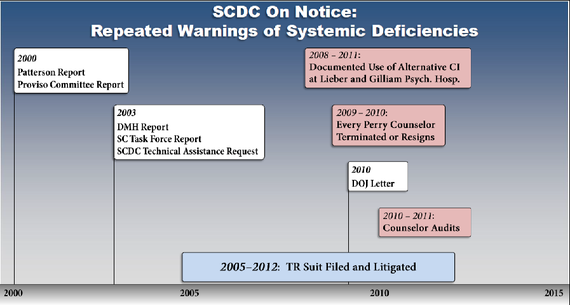
South Carolina’s prisons and jails are overcrowded, under-resourced, and toxic. People, like Joyce Curnell, regularly die in agony, begging for help. Jails are fatally overcrowded. For example, the Pickens County Jail, built for maximum 91 prisoners, currently holds close to 200. South Carolina’s prisons and jails are bad, but for those living with mental illness, the prisons and jails are absolutely infernal. They are described as negligent, outrageous, abusive, where cruel becomes usual, appalling and worse. People living with mental illness spend years in solitary confinement, engaging in self-harm, and scores have died in agony, begging for help. Finally, after twelve years of struggle, this might just change, thanks to prisoners themselves and to Protection and Advocacy for People Living with Disability.
In 2002, Protection and Advocacy and the Death Penalty Resources Center approached a prominent South Carolina law firm and asked for help concerning the systemic abuse of prisoners living with mental illnesses. The lawyers took on the case. In 2005, three inmates – T.R., P.R. and K.W. – and Protection and Advocacy sued the South Carolina Department of Corrections and its director, William R. Byars, Jr. They laid out a horror story of abuse, neglect, mayhem, torture, pain, suffering, and death. The details were horrifying as was the scale. In 2012, the case went to trial. In 2014, Judge Michael Baxley ruled decisively against the State. He opened his remarks noting, “It has been the privilege of this writer to serve the State of South Carolina as a general jurisdiction judge for fourteen years. At the time this case was heard, Court Administration reported there were more than 5,000 new case filings per year for each of our state’s circuit court judges. Thus, over 70,000 cases of every imaginable sort have come to this Court over the years. This case, far above all others, is the most troubling … The evidence in this case has proved that inmates have died in the South Carolina Department of Corrections for lack of basic mental health care, and hundreds more remain substantially at risk for serious physical injury, mental decompensation, and profound, permanent mental illness.”
Judge Baxley handed down his decision January 2014. South Carolina immediately leapt to the defense of its clearly abusive and troubling treatment of those living with mental illness. Meanwhile, self injury and harm continued unabated. A year later, in January 2015, an agreement between the parties was reported, but that proved not to be the case. Finally, this week, a final agreement – with real goals, timelines, independent checks and assessments, and a budget – was signed.
South Carolina built a special hell for those living with mental illnesses. Its ratio of mentally ill in prison or jail to mentally ill in hospital is 5.1 to 1, one of the worst in the country. South Carolina is near the bottom of state rankings when it comes to “availability of public psychiatric beds, efforts to divert mentally ill individuals, per capita state mental health expenditures, and almost every other measure of treatment for mentally ill individuals.” Furthermore, when it comes to investing in prisoner healthcare, it’s the second worst state in the country. Only Oklahoma is worse.
For decades South Carolina has tortured people living with mental illnesses. It was State public policy, everyone knew. Everyone knew that seriously mentally ill people were sent to solitary more than others, and everyone knew that they stayed in solitary for much longer. Judge Baxley wrote repeatedly that the State was aware of what was happening under and within its administration. This torture was public knowledge, and so the question lingers, “What is that public?” Why does it take spectacular deaths for us to acknowledge the torture we already knows? Why does it take heroic struggles that last for years for us to say that we cannot torture people because they live with mental illnesses? Who are we who know and then turn away? Who are we? This case, far above all others, is the most troubling.
(Image Credit: The Atlantic)